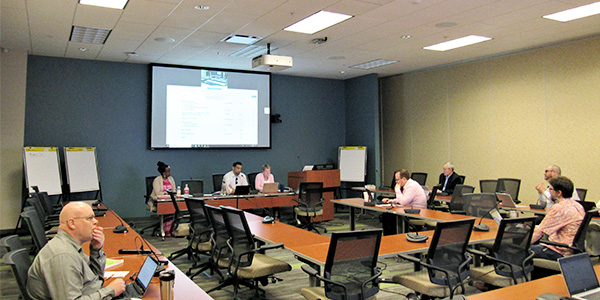By Amanda Durish Cook
CARMEL, Ind. — MISO is still pondering whether to amend its Order 841 compliance filing, after FERC earlier this month rejected multiple requests to alter the landmark order requiring RTOs to provide storage resources access to their markets.
As part of its May 16 ruling (Order 841-A), the commission rejected MISO’s requests to reconsider compliance deadlines and consider a phase-in for minimum size requirements for storage participation. (See FERC Upholds Electric Storage Order.)
“MISO is still reviewing Order 841-A,” Kevin Vannoy, the RTO’s director of market design, said at an Energy Storage Task Force (ESTF) meeting Thursday. “To the extent in our review of the order that we need to review our compliance filing, or amend it, we may or may not do that. We’re still deciding.”
In the meantime, MISO is waiting on FERC to act on its compliance filing, which includes both a request to delay a storage participation model until 2021 and limit the participation of storage resources 1 MW and smaller to 50 in the first year of compliance and 150 in the second year. (See MISO Requests Storage Compliance Delay into 2021.) MISO has said it will gradually increase the number of small storage devices in its market as it “improves its software’s capability to manage them.”
RTO staff have said they expect a response from the commission in July, and Vannoy reminded stakeholders that MISO’s filing is still open for comments.
“FERC has time to review and folks can comment,” he said.
MISO has said its phased approach is a “reasonable precaution to proactively address the potential for large numbers of small electric storage resources, rather than waiting to react to adverse impacts of future high volumes of small electric storage resources.”
But FERC maintains that benefits of increased competition will outweigh complexity and implementation costs.
In Order 841-A, the commission said the 100-kW minimum size requirement is a “balance between the benefits of increased competition fostered by the opportunity for smaller resources to participate in the RTO/ISO markets … and the potential need to update RTO/ISO market clearing software to effectively model and dispatch these smaller resources.”
“We continue to believe that, given the record showing that all RTOs/ISOs are already accommodating the participation of smaller resources in their markets and the commission’s willingness to consider requests to increase the minimum size requirement in the future, we are providing the RTOs/ISOs with adequate time to develop the requisite tariff language and update their modeling and dispatch software to comply,” FERC said.
The commission repeated its position that any RTO experiencing difficulty calculating the market after an influx of storage participation could file a request to increase the minimum size requirement. It also pointed out that its compliance directives don’t include any of the distributed energy resource aggregation rules that were first considered in its original Notice of Proposed Rulemaking, making compliance less burdensome.
“We continue to find that the timeline for compliance and implementation is reasonable,” FERC said, adding that it will not allow individual RTOs to propose their own compliance timelines.
Vannoy said MISO’s request for delay had lined up with the early delivery of its new market system platform by a third-party vendor in 2021.
Next up: Hybrid Resources
The Thursday meeting was the last in-person meet-up of the ESTF before it sunsets next month after a year and a half of service. The group will provide a final report of potential storage topics to the Steering Committee, which will route the items to the appropriate stakeholder committees for possible policy development.
Entergy’s Yarrow Etheredge asked if MISO should consider extending the life of the ESTF because of the uncertainty surrounding the Order 841 compliance filing and a decision is not expected until July.
Task force Chair John Fernandes said stakeholders might consider ad hoc meetings focusing on energy storage, but monthly meetings of the ESTF were no longer necessary.
“Where there is interest in discussing this further, it would be on an as-needed basis,” Fernandes said.
The ESTF’s topic list focuses heavily on how MISO might facilitate market participation for hybrid resources that include both generation and energy storage devices. The group said the RTO should work out how modeling, forecasting and offer data submittals will work for those resources. MISO must also determine allowable capacity factors for the purposes of its Planning Resource Auction. It currently lacks historical data on the charging patterns and behavior of hybrid resources, making capacity factors difficult to determine.
Some stakeholders agreed that hybrid resources are a more pressing matter than storage-as-transmission assets (SATA) because they believe multiple hybrid resources will be built before a SATA project is realized. Others added that if MISO wants to incorporate hybrid resources soon, it needs to rethink its postponement on combined cycle modeling until mid-2023. (See “At Least 1 Market Project Delay,” New MISO Platform Headed to the Cloud.) Multiple stakeholders said better combined cycle modeling and hybrid resource modeling are inextricably linked.





